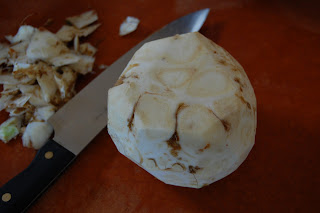 |
| Celeriac seen from the stem end |
For most people, celeriac falls firmly into the “What the F#$!” category of vegetables. While not much to look at, this is a fabulous fall-winter vegetable that is really under appreciated. Beneath the funky, turnip-meets-octopus-tentacle exterior lies a crisp white mild interior. It is also called celery root - so you might guess that it tastes like celery, and you’d be right. Celeriac is actually from a different subspecies, grown especially for its swollen starchy stem base (for you plant geeks, it is technically a corm). The celery-like stems can also be used, but they are more bitter than common celery. Celeriac has a pleasant, mild celery taste and can be used raw, sautéed, roasted, baked or pickled.
 |
| Showing removed rootlets on the left |
To prepare celeriac, cut off the stems close to the base and cut the roots where most of them start to separate from the base and form “fingers”, if they are not both trimmed already. Use a sturdy vegetable peeler or just a knife to peel the outer skin. If you are not cooking it immediately, prepare a bowl of acidulated water[1] to keep the while flesh from browning.
 |
| If cooking, don't worry too much about the remaining areas around the rootlets, you can trim them out as you slice & dice. |
Some ways to use celeriac
 |
| Hanging out in acidulated water (with lemon) |
- Wonderful grated (or julienned) and then marinated for a salad
- Saute with like veggies, such as baby artichoke, fennel and celery for a wonderful hash
- Roast with any of the veggies above, or with potato and carrot for a fabulous side
- Boil with white potatoes to spice up your mash
- Use with your favorite picking blend, or try it with Quick Pickled Onions & Friends
Recipes that feature celeriac: Sunchoke & Celeriac Soup
 |
| Sunchoke & Celeriac Soup - a fall favorite |
[1] Water to which acid has been added to keep food from browning. Generally ~1/2 a lemon or lime, 1.5 tablespoons vinegar or 1/2 cup white wine with 1 quart of water. Adding too much acid can impart its flavor to the food, so think about the type of acid that would work best with your flavors.
No comments:
Post a Comment